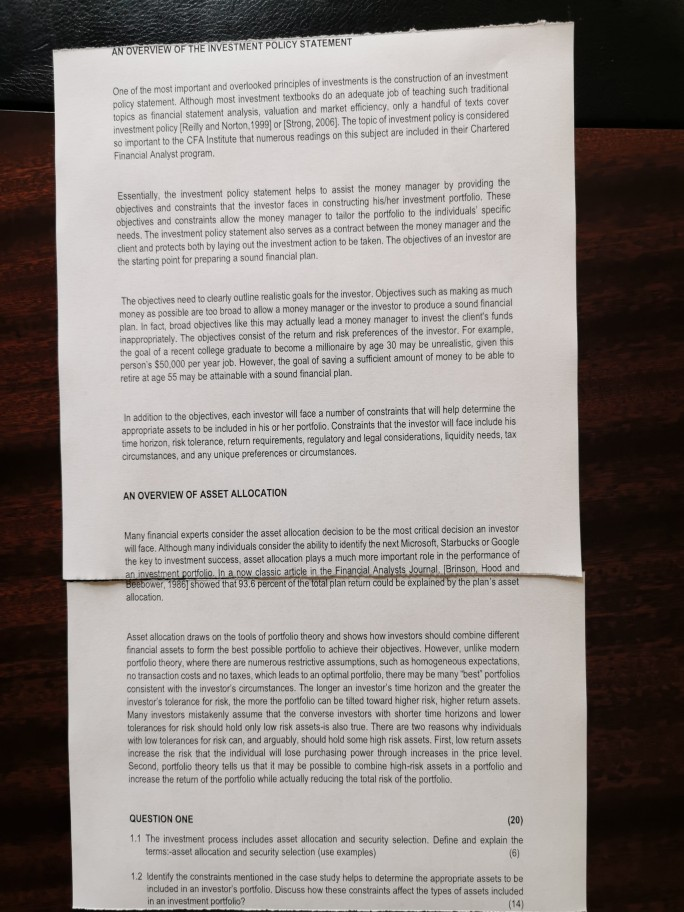Answered step by step
Verified Expert Solution
Question
1 Approved Answer
AN OVERVIEW OF THE INVESTMENT POLICY STATEMENT One of the most important and overlooked principles of investments is the construction of an investment policy statement.

AN OVERVIEW OF THE INVESTMENT POLICY STATEMENT One of the most important and overlooked principles of investments is the construction of an investment policy statement. Although most investment textbooks do an adequate job of teaching such traditional topics as financial statement analysis, valuation and market efficiency, only a handful of texts cover investment policy (Reilly and Norton, 1999) or (Strong, 2006). The topic of investment policy is considered so important to the CFA Institute that numerous readings on this subject are included in their Chartered Financial Analyst program Essentially, the investment policy statement helps to assist the money manager by providing the objectives and constraints that the investor faces in constructing his/her investment portfolio. These objectives and constraints allow the money manager to tailor the portfolio to the individuals' specific needs. The investment policy statement also serves as a contract between the money manager and the client and protects both by laying out the investment action to be taken. The objectives of an investor are the starting point for preparing a sound financial plan The objectives need to clearly outline realistic goals for the investor. Objectives such as making as much money as possible are too broad to allow a money manager or the investor to produce a sound financial plan. In fact, broad objectives like this may actually lead a money manager to invest the client's funds inappropriately. The objectives consist of the return and risk preferences of the investor. For example, the goal of a recent college graduate to become a millionaire by age 30 may be unrealistic, given this person's $50,000 per year job. However, the goal of saving a sufficient amount of money to be able to retire at age 55 may be attainable with a sound financial plan In addition to the objectives, each investor will face a number of constraints that will help determine the appropriate assets to be included in his or her portfolio Constraints that the investor will face include his time horizon, risk tolerance, return requirements, regulatory and legal considerations, liquidity needs, tax circumstances, and any unique preferences or circumstances. AN OVERVIEW OF ASSET ALLOCATION Many financial experts consider the asset allocation decision to be the most critical decision an investor will face. Although many individuals consider the ability to identify the next Microsoft, Starbucks or Google the key to investment success, asset allocation plays a much more important role in the performance of an investment portfolio In a now classic article in the Financial Analysts Journal Brinson Hood and beobower, 1986 Showed that 93.6 percent of the total plan return could be explained by the plan's asset allocation. Asset allocation draws on the tools of portfolio theory and shows how investors should combine different financial assets to form the best possible portfolio to achieve their objectives. However, unlike modern portfolio theory, where there are numerous restrictive assumptions, such as homogeneous expectations, no transaction costs and no taxes, which leads to an optimal portfolio, there may be many best portfolios consistent with the investor's circumstances. The longer an investor's time horizon and the greater the investor's tolerance for risk, the more the portfolio can be tilted toward higher risk, higher return assets. Many investors mistakenly assume that the converse investors with shorter time horizons and lower tolerances for risk should hold only low risk assets-is also true. There are two reasons why individuals with low tolerances for risk can, and arguably, should hold some high risk assets. First, low return assets increase the risk that the individual will lose purchasing power through increases in the price level. Second, portfolio theory tells us that it may be possible to combine high-risk assets in a portfolio and increase the return of the portfolio while actually reducing the total risk of the portfolio (20) QUESTION ONE 1.1 The investment process includes asset allocation and security selection. Define and explain the terms-asset allocation and security selection (use examples) 1.2 Identify the constraints mentioned in the case study helps to determine the appropriate assets to be included in an investor's portfolio. Discuss how these constraints affect the types of assets included in an investment portfolio
Step by Step Solution
There are 3 Steps involved in it
Step: 1

Get Instant Access to Expert-Tailored Solutions
See step-by-step solutions with expert insights and AI powered tools for academic success
Step: 2

Step: 3

Ace Your Homework with AI
Get the answers you need in no time with our AI-driven, step-by-step assistance
Get Started


